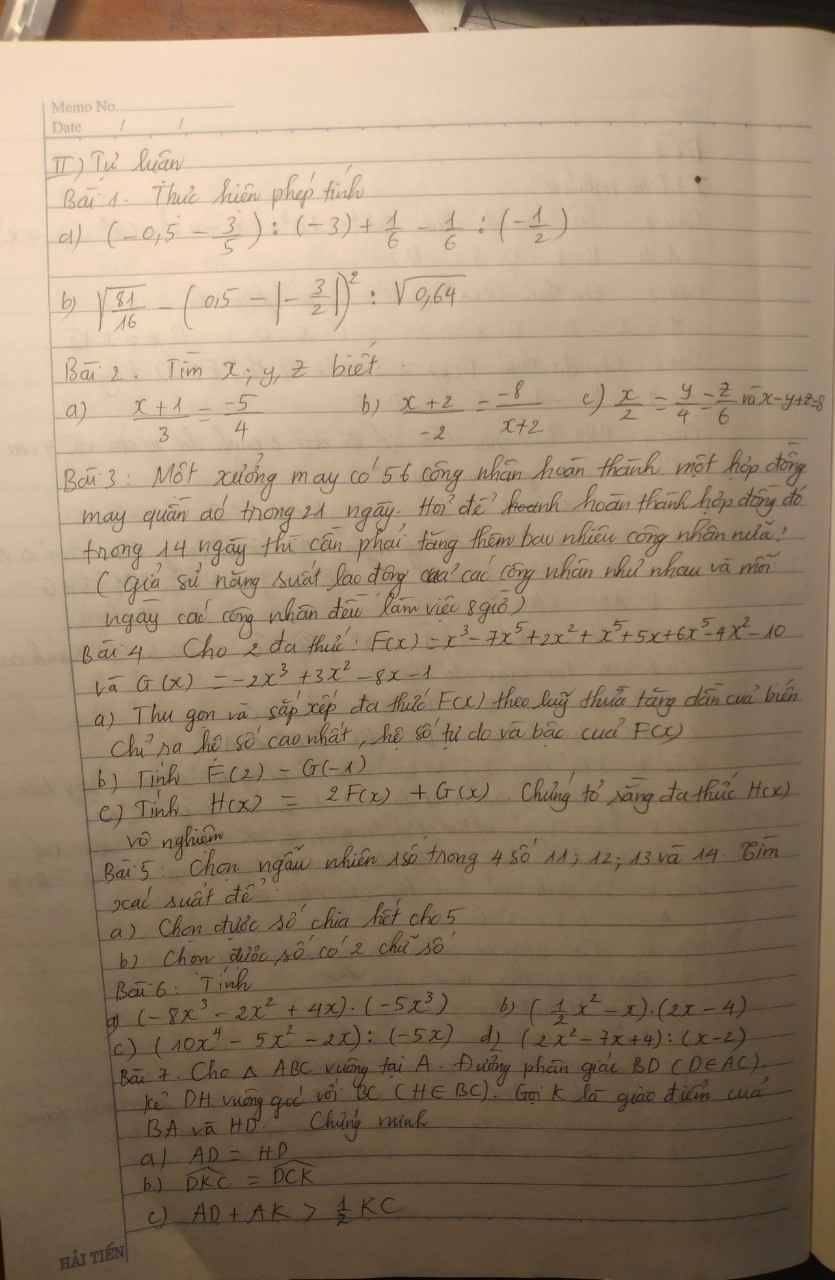Hãy nhập câu hỏi của bạn vào đây, nếu là tài khoản VIP, bạn sẽ được ưu tiên trả lời.

1) \(\left(x^2-4x+3\right)f\left(x+1\right)=\left(x-2\right)f\left(x-1\right)\)
\(\Leftrightarrow\left(x-1\right)\left(x-3\right)f\left(x+1\right)=\left(x-2\right)f\left(x-1\right)\)
Với \(x=1\): \(0=-1f\left(0\right)\Leftrightarrow f\left(0\right)=0\)do đó \(0\)là một nghiệm của đa thức \(f\left(x\right)\).
Tương tự xét \(x=2,x=3\)có thêm hai nghiệm nữa là \(3\)và \(2\).
2) \(f\left(2\right)=4a-2+b=0\Leftrightarrow4a+b=2\)
Tổng hệ số cao nhất và hệ số tự do là \(a+b\)suy ra \(a+b=-7\).
Ta có hệ:
\(\hept{\begin{cases}4a+b=2\\a+b=-7\end{cases}}\Leftrightarrow\hept{\begin{cases}3a=9\\b=-7-a\end{cases}}\Leftrightarrow\hept{\begin{cases}a=3\\b=-10\end{cases}}\).

Em muốn hỏi bài nào vậy? Quá nhiều bài thầy cô và các bạn không thể trả lời được hết em ạ

1. Cho đa thức f (x) thỏa mãn ( x\(^2\) - 4x + 3) .f ( x + 1 ) = (x - 2).f ( x - 1 ). Chứng tỏ đa thức f (x) có ít nhất 3 nghiệm.
\(\left(x^2-4x+3\right).f\left(x+1\right)=\left(x-2\right).f\left(x-1\right)\)
\(\text{* Thay}\)\(x=2\)\(,\)\(\text{ta có:}\)
\(\left(2^2-4.2+3\right)f\left(2+1\right)=\left(2-2\right)f\left(2-1\right)\)
\(\rightarrow\left(4-8+3\right)f\left(3\right)=0.f\left(1\right)\)
\(\rightarrow\left(-1\right).f\left(3\right)=0\)
\(\rightarrow f\left(3\right)=0\)
\(\rightarrow x=3\)\(\text{là một nghiệm của}\)\(f\left(x\right)\)
\(\text{* Thay}\)\(x=1\)\(,\)\(\text{ta có:}\)
\(\left(1^2-4.1+3\right)f\left(1+1\right)=\left(1-2\right).f\left(1-1\right)\)
\(\rightarrow\left(1-4+3\right).f\left(2\right)=-1.f\left(0\right)\)
\(\rightarrow0.f\left(2\right)=-1.f\left(0\right)\)
\(\rightarrow0=\left(-1\right).f\left(0\right)\)
\(\rightarrow f\left(0\right)=0\)
\(\rightarrow x=0\)\(\text{là một nghiệm của}\)\(f\left(x\right)\)
\(\text{* Thay}\)\(x=3\)\(,\)\(\text{ta có:}\)
\(\left(3^2-4.3+3\right).f\left(3+1\right)=\left(3-2\right).f\left(3-1\right)\)
\(\rightarrow\left(9-12+3\right).f\left(4\right)=1.f\left(2\right)\)
\(\rightarrow0.f\left(4\right)=1.f\left(2\right)\)
\(\rightarrow0=1.f\left(2\right)\)
\(\rightarrow f\left(2\right)=0\)
\(\rightarrow x=2\)\(\text{là một nghiệm của}\)\(f\left(x\right)\)
\(\text{Vậy ...}\)

a, \(P=-x^4+x^3+x^2-5x+2\)
hế số cao nhất 2 ; hế số tự do 2 ; bậc 4
\(Q=-3x^2+2x^2+6x+3x^4-3x^3-5x-2=3x^4-3x^3-x^2+x-2\)
hệ số cao nhất 3 ; hệ số tự do -2 ; bậc 4
b, \(M=-3x^4+3x^3+3x^2-15x+6+3x^4-3x^3-x^2+x-2=2x^2-14x+4\)

a) P(x) = -2x^2 + 4x^4 – 9x^3 + 3x^2 – 5x + 3
=4x^4-9x^3+x^2-5x+3
Q(x) = 5x^4 – x^3 + x^2 – 2x^3 + 3x^2 – 2 – 5x
=5x^4-3x^3+4x^2-5x-2
b)
P(x)
-bậc:4
-hệ số tự do:3
-hệ số cao nhất:4
Q(x)
-bậc :4
-hệ số tự do :-2
-hệ số cao nhất:5

Thu gọn x3 + 2x5 - x4 + x2 - 2x3 + x - 1
= 2x5 - x4 - x3 + x2 + x - 1
Hệ số cao nhất là 2, hệ số tự do là -1. Tổng là 2 + (-1) = 1. Chọn C